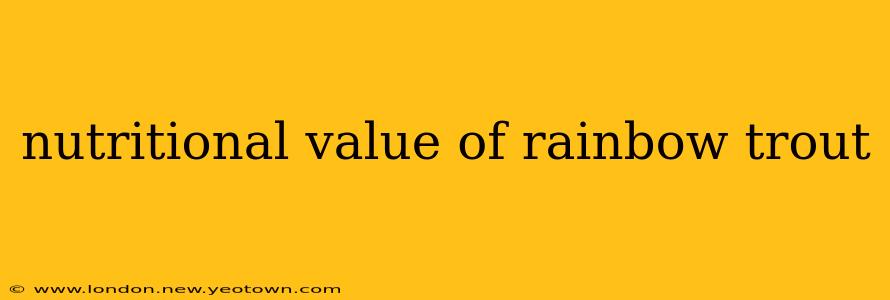The shimmering scales of a rainbow trout, reflecting the vibrant colors of its namesake, hint at the nutritional treasure within. This freshwater fish isn't just delicious; it's a powerhouse of essential nutrients that contribute significantly to a healthy diet. Far from being a mere protein source, rainbow trout offers a surprisingly diverse profile of vitamins, minerals, and healthy fats that benefit your overall well-being. Let's dive deeper into this culinary and nutritional gem.
What are the key nutritional benefits of rainbow trout?
Rainbow trout is exceptionally rich in high-quality protein, crucial for building and repairing tissues, supporting immune function, and maintaining healthy muscles. But its nutritional profile extends far beyond protein. It’s a fantastic source of omega-3 fatty acids, particularly EPA and DHA, known for their anti-inflammatory properties and positive impact on heart health, brain function, and even mood regulation. These healthy fats aren't just good for you; they also contribute to the trout's delicious, rich flavor.
Beyond omega-3s, rainbow trout is a good source of several vitamins and minerals. Vitamin D, crucial for bone health and calcium absorption, is naturally present in this fish. Selenium, an antioxidant that protects against cell damage, is another key nutrient found in abundance. Furthermore, rainbow trout contributes a good helping of niacin, vitamin B12, and phosphorus, all essential for various bodily functions.
How does rainbow trout compare to other fish nutritionally?
Compared to other popular fish like salmon, rainbow trout holds its own in terms of nutritional value. While salmon often boasts slightly higher levels of omega-3s, rainbow trout provides a comparable nutritional punch at a generally more accessible price point. It's a more sustainable option in many regions as well. The differences are marginal in most cases, meaning rainbow trout makes an excellent alternative for those seeking the health benefits of fatty fish.
Is rainbow trout high in mercury?
This is a crucial question for many health-conscious individuals. Thankfully, rainbow trout is generally considered a low-mercury fish. Unlike larger predatory fish that accumulate mercury higher up the food chain, rainbow trout's position lower in the aquatic ecosystem keeps its mercury levels relatively low, making it a safe choice for regular consumption, even for pregnant women and young children. Always check for local advisories, however, as mercury levels can vary slightly based on geographic location and environmental factors.
What are the best ways to prepare rainbow trout to preserve its nutrients?
To fully enjoy the nutritional benefits of rainbow trout, aim for preparation methods that minimize nutrient loss. Baking, grilling, and pan-frying are all excellent choices. Avoid overcooking, which can make the fish dry and reduce the bioavailability of certain nutrients. Steaming is another gentle cooking method that preserves the delicate texture and nutritional value of the trout. Adding a squeeze of lemon or herbs enhances the flavor without adding unnecessary calories or sodium.
How much rainbow trout should I eat per week?
The recommended amount of rainbow trout (or any fish) per week varies depending on individual dietary needs and health conditions. However, incorporating rainbow trout into your diet 1-2 times a week is a fantastic way to boost your intake of omega-3s, protein, and essential vitamins and minerals. Consult with a healthcare professional or registered dietitian for personalized dietary advice based on your specific circumstances. Remember to always practice safe food handling and preparation to avoid any potential health risks.
The rainbow trout, with its vibrant appearance and rich nutritional profile, deserves a prominent place on your plate. Its versatility in the kitchen and significant health benefits make it a truly valuable addition to a well-balanced diet.

